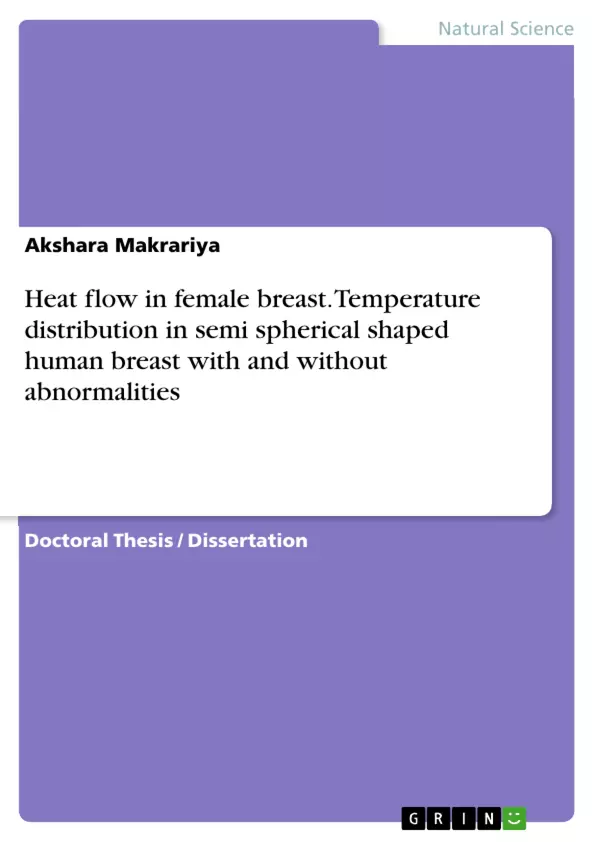This thesis is divided in the following order. The first, two chapters respectively deal with the physiological and mathematical background necessary for the study of heat flow in female breast. Chapter-3 is devoted to analytical and numerical solutions to study temperature distribution in spherical organs of a human body for a one dimensional steady state case. Chapter-4 and 5 deals with two dimensional finite element models to study temperature distribution in semi spherical shaped human breast with and without abnormalities like tumor.
The development of quantitative methods and computer technology has facilitated the formation of new models in medical and biological sciences. Further, the application of mathematical methods in solving many real world problems of medicine and biology has yielded fruitful results. Despite advancements in instrumentations technology and biomedical equipments, it is not always possible to perform experiments in medicine and biology due to various reasons. Thus mathematical modeling and simulation is viewed as an viable alternative in such situations. The problems of biology and medicine pose new challenges for modeling and simulation.
Attempts are in progress world wide for mathematical modeling of control systems of human body as these systems are highly sophisticated systems and poorly understood. The temperature regulation system of a human body is one of the important control systems involved is maintaining structure and function of human body organs. The study of temperature regulation system of human body organs is quite interesting both from application and mathematical point of view. The modeling of these problems poses new challenges for mathematics. In view of above the theoretical study entitled “Computational Models To Study Temperature Distribution In Extended Spherical And Ellipsoidal Shaped Human Organs” has been taken up.
Table of Contents
- CHAPTER 1
- PHYSIOLOGICAL BACKGROUND
- INTRODUCTION
- THERMOREGULATION
- THERMOANALYSIS
- THERMOGENESIS
- HEAT TRANSPORT FROM CORE TO THE BODY SURFACE THROUGH SKIN
- SKIN AND SUBDERMAL TISSUES
- EPIDERMIS
Objectives and Key Themes
This chapter aims to provide a comprehensive overview of the physiological processes involved in thermoregulation in the human body, focusing on the interplay between heat generation and heat loss to maintain a stable core temperature. The chapter explores the importance of maintaining thermal balance for overall health and how disruptions to this balance can lead to various health issues.
- Thermoregulation and the importance of maintaining a stable core body temperature.
- The role of heat generation (thermogenesis) and heat loss (thermoanalysis) in thermoregulation.
- The mechanisms of heat transfer within the body and to the environment, including conduction, convection, radiation, and evaporation.
- The structure and function of the skin and subdermal tissues in relation to thermoregulation.
- The impact of abnormal physiological conditions, such as cancer, on thermoregulation.
Chapter Summaries
Chapter 1 delves into the physiological mechanisms underpinning thermoregulation in the human body. It begins by introducing the various control systems present within the body, highlighting the importance of the temperature regulation system. The chapter then dives into the process of thermoregulation, explaining how the body maintains a stable core temperature through a delicate balance between heat generation and heat loss. The chapter explores various methods of heat transfer, including conduction, convection, radiation, and evaporation, and examines how these processes contribute to the body's ability to regulate its temperature. The chapter also delves into the role of the skin and subdermal tissues in thermoregulation, detailing their structure and function in the heat transfer process. Finally, the chapter touches upon the impact of abnormal physiological conditions, such as cancer, on thermoregulation, emphasizing the importance of understanding these disruptions for potential disease detection and treatment.
Keywords
This chapter focuses on the key concepts of thermoregulation, including heat generation (thermogenesis), heat loss (thermoanalysis), mechanisms of heat transfer (conduction, convection, radiation, evaporation), the role of the skin and subdermal tissues, and the impact of abnormal physiological conditions on thermoregulation.
- Citation du texte
- Akshara Makrariya (Auteur), 2013, Heat flow in female breast. Temperature distribution in semi spherical shaped human breast with and without abnormalities, Munich, GRIN Verlag, https://www.grin.com/document/1152372



